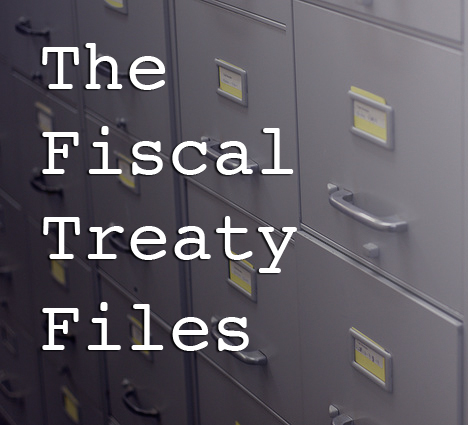The Fiscal Treaty files: How much will it cost?

While there are many questions to be asked and answered during the referendum campaign on the Fiscal Treaty, let’s start with asking about its cost. By Michael Taft.
The very first question that should be answered is how much more austerity the passage of the Fiscal Treaty will mean. After all, this is a ‘fiscal’ treaty. It is intended to have an impact on Government budgets. So the first question should be: what fiscal impact will this fiscal treaty have on Ireland’s fiscal policy.
Answers such as “Oh, this treaty is about growth, jobs, stability,” etc. etc. are not acceptable. The particular question here is: How much more austerity? It is an issue that can be measured (insofar as measuring structural deficits can be considered reliable). Let’s see if we can come up with some kind of answer.
By 2015 the Government estimates that the structural deficit will be 3.7% of GDP. The Treaty stipulates a target of 0.5%. That means the Government will have to reduce the deficit by another 3.2%.
In money terms, that amounts to a gap of €5.7 billion in 2015. This need not be addressed in the period up to 2015. But it would have to be addressed afterwards – meaning at least another two to three years of austerity budgets.
Now here’s where it gets a bit more difficult.
Even the Government doubts this structural deficit figure of 3.7%, because it is based on (in their words) an "unrealistic" scenario and is "highly uncertain". So maybe it will be less. However, it could be more.
When we turn to the IMF we get another, more benign estimate. They claim that the structural deficit will be 2.3% by 2015. That’s significantly less than the Government estimates and indicates that the amount of austerity needed to bring us to the Fiscal Treaty target might not be as much as indicated by the Government. But there’s a little catch here (besides the obvious – how do you determine policy on a measurement that produces such varying results?).
The IMF estimates continue to 2017. They assume there will be no austerity in 2016 and 2017, since the Government hasn’t announced any. As a result, the IMF projects little change in Ireland’s structural deficit in 2017 (2.1%).
And when we look at the impact of austerity between 2011 and 2015, we find an interesting ratio: €1 billion in spending cuts/tax increases coincided with a reduction of the structural deficit by €500 million. This is not necessarily a cause and effect – much depends on other elements in this ‘abstract’ calculation (potential GDP growth, output gap, etc.). But let’s run with this ratio.
If applied to the IMF estimate, we may be looking into approximately €5.9 billion in austerity measures after 2015 to reduce the structural deficit to 0.5%. This corresponds with the Department of Finance’s gap of €5.7 billion.
So on the basis of two measurements produced by two agencies we come up with nearly €6 billion in more austerity measures.
Of course, the Government can easily provide its own estimate. There is no doubt that they are working the numbers now if they haven’t come up with a figure already. It would be bizarre if they weren’t.
Industrious TDs should start putting down questions to the minister – even as a public information service.
Or the Government could produce the numbers when they publish their Stability Programme Update in April – since they would be estimating the structural deficit anyway in this document.
So while there are many questions to be asked and answered during this campaign, let’s start with the cost. What is the fiscal impact on Ireland’s fiscal policy? After all, it is a ‘fiscal’ treaty.
It deserves to be answered. And if Government ministers refuse to answer...well, you can draw your own conclusions. {jathumbnailoff}
notesonthefront.typepad.com
 This article is part of our Fiscal Treaty Files series. For more of our coverage of the Fiscal Treaty click here.
This article is part of our Fiscal Treaty Files series. For more of our coverage of the Fiscal Treaty click here.
Image top: Images_of_Money.
